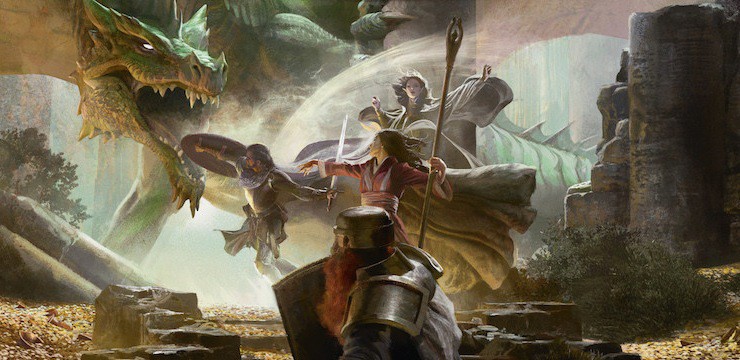There is one pressing, crucial question that you need to ask yourself when you set out to make a Dungeons & Dragons movie. It’s not a matter of what setting to put the movie in, or what characters to have in it, or even what the story is going to be about. It’s a question I touched on when I last mused about what it would take to make a good Dungeons & Dragons movie, and it’s been gnawing away at the back of my mind ever since.
That question is, in a nutshell: is the Dungeons & Dragons movie going to break the “Fourth Wall?”
It’s true that Dungeons & Dragons has done wonders for stabilizing what we think of as “Western fantasy,” with its pointy eared elves and stocky dwarves becoming the new standard of what we think of as fantasy fiction, a set of core assumptions that have spread & grown thanks to the influence of the hobby. I like to think of it personally as the continuation of J.R.R. Tolkien’s work building a legendarium in order to create an “English mythology.”
This puts any Dungeons & Dragons movie in a hard place. A lot of the worldbuilding done in the last thirty years has culminated into the default state for fantasy. Orcs, dragons, treasure, traps, the aforementioned demi-humans… the core of D&D is well-trod territory to even casual fans of fantasy. This has upsides, as it can save time when it comes to exposition—we get it, elves live in the woods, dwarves like axes, wizards cast spells—but also means there is a risk of seeming unoriginal.
But Dungeons & Dragons is filled with bizarre and unique concepts that can do double duty in a film. If you put a mindflayer or beholder in your movie, you’ll both get the scare-factor for people unfamiliar with squid-headed Cthluhu aliens in their fantasy in addition to the sly nod from the gamers in the audience who catch the reference. You can’t just use them as a meaningless MacGuffin or cameo, of course; if you throw them into the script without context or without them mattering, well then shame on you.
The thing is, that’s not what makes Dungeons & Dragons…well, D&D. If you ask me what makes D&D unique, what is the defining element of D&D, it’s that it is a roleplaying game. Perhaps the iconic RPG. That is what defines Dungeons & Dragons. Not fighters, magic-users, clerics and thieves, or even gonzo notions like Spelljammer spaceships or Planescape slang; it’s the collaborative storytelling & the dichotomy between Player and Character that lie at the heart of the game.
So what you need to do to make a Dungeons & Dragons movie that really matters is borrow a page from the old Dungeons & Dragons cartoon, or better yet from The NeverEnding Story, and get a bit post-modern.
RPGs are weird, from the standpoint of fiction. You peek behind the curtain of the Wizard of Oz by their very nature. Everyone, from the Game or Dungeon Master to the rawest new player is an actor, a writer, and the audience, all at once. You are telling a story and playing a game. It’s difficult to break the Fourth Wall without bursting the bubble, but that’s the sweet spot that the D&D movie should shoot for if they really want to make a mark.
A roleplaying game is the ultimate in exploded narrative, the ultimate deconstructed novel. A story we all tell together with dice and math to add randomness, and a layer of complexity on top of that chaos? There’s nothing else like it—and that is what I think a good D&D movie should exploit. (As a sidenote, to see this in reverse, the experimental writing of Jeff Noon is being turned into a Vurt RPG as his style is already half-way deconstructed.)
I don’t think the “portal fantasy” of the ’80s D&D cartoon is the way to go, honestly. “Four unlikely heroes from another world” is a trope that we’ve seen plenty. The NeverEnding Story or something like Tarsem Singh’s The Fall are better examples of how to execute this sort of idea. Anchoring the story in the “real” world with a frame device that allows you the freedom to tell your fantastic tale unfettered, and gives you the chance to cut back, to add a new layer to the story.
This is a risky throw of the dice I’m proposing, pun absolutely intentional. It might be hard to pitch a meta-fictional plot line to a movie studio—but then again, we are in the best moment of film history to do so. Dungeons & Dragons has the same minutia and fan obsession counterbalanced by fun and accessibility that has made the Marvel Cinematic Universe so successful, plus a turn towards the post-modern and experimental—and Nolan’s Batman films show that those can be a financial success, as well. Now is the time, now is our chance!
What makes Dungeons & Dragons so special, at its heart, is that it is a roleplaying game. Arguments over what setting to use or what module to base it on or what iconic characters to include are beside the point; it isn’t Drizzt or Raistlin that defines D&D. It isn’t Greyhawk or Dark Sun, The Temple of Elemental Evil or Castle Ravenloft that makes D&D what it is. What I want to see from the movie is some reflection of the game table, of the real heart of the hobby. It would be hard to pull of, but that’s what could truly make a Dungeons & Dragons movie not just “good,” but great.
Mordicai Knode is the Marketing & Publicity Manager for Tor.com Publishing. Find him on Twitter or Tumblr!










